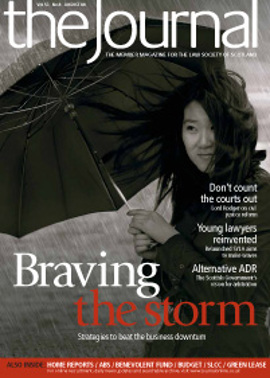Questions, questions

A form of self-assessment questionnaire is available from Marsh and may be viewed or downloaded from the Marsh website for Scottish solicitors, www.marsh.co.uk/lawsociety (userID and password have been issued previously and are available from the author by email – alistair.j.sim@marsh.com). This contains a set of 80 self-assessment questions which might be adopted as a basis for an initial appraisal of a firm’s risk controls and developed into a more comprehensive question set for assessing progress from time to time.
On the subject of self-assessment, it may be interesting and useful to consider how you and your firm would answer risk-related questions in the proposal forms and questionnaires of professional indemnity insurers of solicitors under different insurance regimes in other jurisdictions, where the ability to demonstrate the thoroughness and effectiveness of a firm’s risk controls may be an important factor, as is the firm’s claims record, in securing cover on satisfactory terms.
Typically, the questions which tend to feature in these proposal forms are of two types. Some take the form of generic questions about the firm’s risk controls and its approach to risk management generally; these are not dissimilar to the sort of question which features in the self-assessment questionnaire mentioned above. The other type are transaction-specific (or risk-specific) questions aimed at establishing the extent of awareness and controls in operation in the practice in relation to specific risks which have manifested themselves in adverse claims experience, or reflect the particular insurer’s view of current and emerging risks.
Recruitment
Some proposal forms ask about the firm’s approach to taking up references when recruiting employees and hiring new partners. Questions tend to be along the following lines:
Do you always obtain satisfactory written references when engaging new partners and employees?
Do you verify qualifications, previous experience, previous claims and circumstances?
In certain office insurance policies and fidelity guarantee policies, there are “references conditions” requiring that satisfactory references are obtained for personnel whose duties include handling of cash, ordering of goods and stationery, paying invoices etc. Compliance with these references conditions is a condition of cover.
Client vetting
Does the practice have documented procedures in place for client vetting and identifying conflicts of interest?
The requirement to comply with anti-money laundering regulations means that all solicitors are required to undertake certain vetting processes in relation to new clients. How effective those processes are in detecting (or deterring) potential money launderers or money laundering activity is an interesting question.
However, there is a wider risk management benefit for solicitors in any vetting process which results in knowing the client, the client’s business and the client’s objectives.
Is the prospective client one whose expectations are reasonable and capable of being satisfied?
Is their timescale achievable?
Is the outcome deliverable?
Do you really want to take on someone who has already consulted three or four other solicitors on the same matter, or would you prefer to avoid the risk that yours might be the fourth or fifth firm to disappoint the client and to incur a complaint or a claim? Will they pay fees and outlays promptly in accordance with agreed terms of engagement/business?
Insurers ideally want to be able to see tangible evidence of the practice’s approach, and the word “documented” in the question is therefore significant. It is more difficult to ensure consistency of application of an undocumented approach, however sound. How would it be conveniently and consistently imparted to new recruits, across teams, departments and branch offices? How would compliance be audited? How would the approach be demonstrated to insurers (or, if required, to regulators)?
File notes
Lack of attendance notes is often identified by insurers and panel solicitors as a significant handicap in presenting a successful defence on behalf of an insured practice in the event of a claim. In the absence of a file note, it is difficult for a practice to provide supporting evidence for its version of events, where the client has a contrary recollection. With a file note to support the solicitor’s recollection, the prospects of successfully defending the complaint or claim will be improved.
It is therefore unsurprising that included in insurers’ risk management questions, there is often a question requesting information on the firm’s approach to recording conversations with clients and others in relation to client work.
Are all relevant telephone conversations the subject of a note on the file?
In the article “Note it down – or lose out” (Journal, October 2006, 38), the conclusion is: “Whether file notes are handwritten, or typed, or take the form of copies of emails to the client rehearsing what had just been discussed, they have a vital role to play in your practice’s risk controls.”
Claims and complaints
Do you have procedures in place throughout the firm for registering claims and complaints?
It makes sense for a number of reasons for there to be clarity about who has responsibility for handling claims and complaints, including who has responsibility for notifying insurers to comply with the terms of the firm’s professional indemnity insurance.
Does the practice have a designated individual responsible for the handling of complaints and claims?
If claims or potential claims are addressed promptly and effectively, there is a possibility of minimising the adverse impact of an error or omission. Potentially, by handling these situations skilfully, with insurers’ involvement or input as appropriate, the firm may avoid losing an important client.
The opportunity to learn lessons and minimise the risk of repetition ought to be seized as one of the few positive aspects of a complaint or a claim against the firm. See the article “Learning lessons that lessen risk” (Journal, December 2000, 36). Some insurers, as a condition of renewing cover, will require insured practices to demonstrate that any notified claims have been analysed for causes, contributory factors and preventive action plans.
With effect from 1 November 2007, the Society’s Insurance Committee launched a pilot exercise encouraging practices to analyse claims on their records and devise action plans to prevent recurrence.
File audit/review
Does the practice carry out regular audits/reviews on all active files (including partners’ files)? Provide details
Having established that there are appropriate controls in place, it makes sense to perform checks to establish that the controls are being observed and that they work in practice.
File audit can present practical, logistical and resourcing challenges. There are potentially difficult issues of perception and sensitivities for colleagues around why their files are being reviewed. However, if these challenges are addressed effectively, auditing has benefits in providing management information on a range of risk management issues.
It is one way that a firm is able to demonstrate to itself, to insurers or to regulators, if required, that its partners and staff are actually complying with its risk management policies and procedures. The process may highlight inconsistencies between fee earners, areas of practice, departments, offices etc and may identify the need for training or for refinement of existing controls, all with a view to improving compliance. It should highlight any systems which do not work at a practical level and provide a benchmark against which to assess progress with development of the practice’s overall management of risk.
In considering how best to plan and implement a file audit in your practice, it might be of interest to consider what outcomes you are aiming to achieve. From a risk management perspective, the desired outcome might be to establish whether there are risk controls in place to cover common causes of claims, and where there are controls, whether these are being operated correctly by all fee earners. Consider how the findings depicted in the table and charts below might be elicited in the most efficient and convenient way. Are these findings potentially worthwhile in assessing the effectiveness of the practice’s risk controls? Could they perhaps be elicited by non-fee earning staff? Could the findings be generated by using case management software?
Critical dates
It is not surprising that insurers’ risk management questions tend to include questions concerning the operation of the firm’s systems and procedures for avoiding missed deadlines and critical dates.
Does the practice make regular checks to ensure that the diary system in which all key dates are entered is being adhered to?
The questions typically point up the fact that the firm’s systems need to be understood and adhered to consistently by everyone; that there need to be fail-safes built in to deal with the exceptional case that slips through the net; and that there needs to be monitoring of compliance.
File closure
Does the practice have formal file closure procedures? Are procedures in operation for all practice areas/departments?
In property transactions, for example, claims have arisen because of failure to follow up implementation of outstanding undertakings, deal with funds consigned on joint deposit etc. Arguably this occurs because of failure in the file closing process – a checklist or a file audit might prompt appropriate action.
Transaction-specific risks
There are questions in some insurers’ proposal forms (or separate questionnaires) that are aimed at transaction-specific risks. The presence of questions on these themes indicate either that there has been adverse experience of claims arising out of that particular type of transaction or that insurers have a concern about the risk of an adverse trend, either frequency or severity or both, in claims from that type of transaction.
Consider the set of questions in the article “For the high jump” (Journal, April 2007, 38), prompting firms to consider how options-related risks are being addressed.
Mortgage fraud
Concerns are being expressed about the exposure of solicitors to claims arising out of mortgage fraud perpetrated by borrowers on lending institutions. The techniques adopted by those involved are apparently little different to those which resulted in a raft of claims in the 1990s. Mortgage fraud risk has been addressed in this year’s Risk Management Roadshow, in recent issues of the Journal, and in guidance, for example “Tips on identifying mortgage fraud” on the Society’s website.
Equity release
The combination of value and complexity, together with the fact that equity release is a form of borrowing most popular with elderly clients, and the possibility of negative equity leaving equity release borrowers exposed, are all factors that have led PII insurers to flag up such schemes with solicitors as a serious risk issue which should be treated with caution and to ask questions about the extent to which firms have been involved in advising clients on these arrangements.
See the article “Future perfect?” (Journal, August 2007, 36). 0
Alistair Sim and Marsh
Alistair Sim is a former solicitor in private practice who works in the FinPro (Financial and Professional Risks) National Practice at Marsh, the world’s leading risk and insurance services firm. To contact Alistair, email: alistair.j.sim@marsh.com .
The information contained in this article provides only a general overview of subjects covered, is not intended to be taken as advice regarding any individual situation and should not be relied upon as such. Insureds should consult their insurance and legal advisers regarding specific coverage issues. Marsh Ltd is authorised and regulated by the Financial Services Authority.
In this issue
- Where have we come from, where to next?
- Shifting sands
- A rank bad rule
- Braving the storm
- Civil justice: where next?
- Title Conditions Act: new registration procedures
- Young lawyers reborn
- Shining some more light...
- Power to the tribunal?
- Piece by piece
- The poor in our midst
- The Society's future role in complaints handling
- Appreciation: Lord Johnston
- Professional Practice Committee
- Facing the lean years
- It's a web 2.0 world
- Questions, questions
- Bare necessities
- Coming on the blind side
- Relocation, relocation
- Worse than the disease?
- Sleeping bounty
- Scottish Solicitors' Discipline Tribunal
- Website reviews
- Book reviews
- Industry standard
- Meet the committee
- What's in a motto?
- Leasing by example
- Good call?
- Home reports - the practice questions






